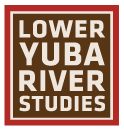Floods
Introduction
A channel is a conduit for water that tends to have a geometrical form sized and shaped to carry an amount of water roughly equal to the peak flow that occurs ever year to once every 3 years. A flood occurs when water spills out of the channel, and thus is expected to occur as often as once every 1-3 years. Thus, floods are not rare, but common occurrences in rivers. The larger the flood, the more rare is its occurrence. Often people refer to floods on a statisticla basis, such as the one that occurs with a 1% chance in every year, which is also called the "100-year flood". To convert between statisticall recurrence interval and percent, simply divide the number 100 by the years of interest. For exmaple, the 10-year flood has a percent chance of 100/10, which equals 10%. The 2-year flood has a percent chance of 100/2, which equals 50%.
Past Flood Studies
- DWR and USACE (2003) report the largest floods at the gages affecting the LYR.
- MBK (2006) provided a list of reports about flooding and drainage issues in Yuba County. It also summarized the findings about flood control infrastructure. They state that a serious threat exists along the LYR due to the ever-present possibility of levee failure and that the dams in the system can only provide protection for floods up to the ~70-year event.
- Moir and Pasternack (2008) and Pasternack (2008) performed flood frequency analysis for the pre-Englebright (before 1942), Englebright-to-New Bullards Bar (NBB) (1942-1971), and NBB-to-present (1971-2004) time series using the Smartville gaging station data. They found the present-day statistical bankful discharge to be 5,620 cfs and that for pre-NBB to be 11,600 cfs. The 2-, 5-, 10-, and 50-yr return interval discharges for 1971–2004 were 10,600, 37,000, 51,200, and 142,00 cfs, respectively.
- MEI (2008) performed flood frequency analysis using the Marysville gaging station data (actual span of years used were not reported, but might have included all years irrespective of dam regimes). The 2-, 5-, and 10-year recurrence interval peak flows were found to be 17,100, 48,000 and 80,500 cfs, respectively.
- Pasternack (2008) performed an analysis of flood types using the Flood Regime Characterization computer code for MATLAB 7 written by Eric Booth (UC Davis Hydrologic Sciences M.S. student) in 2006. This code analyzes the magnitude and duration of flood events from a daily discharge time series to create classes of flood types. This classification process is facilitated by expert-based input of significant hydrologic and geomorphic thresholds. Once flood types are created, then water year types are created by clustering similar water years together based on the number of days each flood type occurs during each water year. The frequency of each water year type throughout the record is also calculated.
Current Flood Frequency Values
- Wyrick and Pasternack (2012) included an updated flood frequency analysis for the modern LYR flow regime spanning 1970-2010. It was done using the software HEC-SSP. The values computed in this study are shown in the table below:
| Return Period (yrs) | Discharge (cfs) |
| 500 | 385,729 |
| 200 | 287,324 |
| 100 | 223,917 |
| 50 | 169,397 |
| 20 | 110,016 |
| 10 | 73,980 |
| 5 | 44,980 |
| 2 | 16,464 |
| 1.25 | 5,612 |
| 1.11 | 3,106 |
| 1.05 | 1,877 |
| 1.01 | 702 |
Bibliography
- DWR and USACE, 2003. Daguerre Point Dam Fish Passage Improvement Project 2002 Water Resources Studies (Stakeholder Review Draft). Prepared by Entrix, Inc.
- MBK. 2006. Yuba County Multi-Jurisdictional Multi-Hazard Mitigation Plan Comprehensive Flood Study, Appendix A: Water Resources Review Document Summary Report. MBK Engineers, Sacramento, CA, 67 p.
- MEI. 2008. Two-dimensional Modeling to Evaluate the Alternative 2-C Fish Screen Design Yuba River California. Mussetter Engineering, Inc., Fort Collins, CO, 64 p.
- Moir, H. J. and Pasternack, G. B. 2008. Relationships between mesoscale morphological units, stream hydraulics and Chinook salmon (Oncorhynchus tshawytscha) spawning habitat on the Lower Yuba River, California. Geomorphology 100:527-548.
- Pasternack, G. B. 2008. SHIRA-Based River analysis and field-based manipulative sediment transport experiments to balance habitat and geomorphic goals on the lower Yuba River. Cooperative Ecosystems Studies Unit (CESU) 81332 6 J002 Final Report, University of California at Davis, Davis, CA, 569pp.
- Wyrick, J. R. and Pasternack, G. B. 2012. Landforms of the Lower Yuba River. Prepared for the Yuba Accord River Management Team. University of California at Davis, Davis, CA, 91pp.
